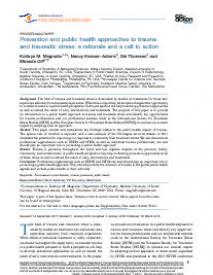Prevention and public health approaches to trauma and traumatic stress: a rationale and a call to action
Background: The field of trauma and traumatic stress is dominated by studies on treatments for those who experience adversity from traumatic experiences. While this is important, we should not neglect the opportunity to consider trauma in a public health perspective. Such a perspective will help to develop prevention approaches as well as extend the reach of early interventions and treatments. The purpose of this paper is to provide an introduction to a public health approach to trauma and traumatic stress and identify key opportunities for trauma professionals and our professional societies (such as the International Society for Traumatic Stress Studies [ISTSS] and the European Society for Traumatic Stress Studies [ESTSS]) to increase our societal impact by adopting such an approach.
Method: This paper reviews and summarizes key findings related to the public health impact of trauma. The special case of children is explored, and a case example of the Norwegian terrorist attacks in 2011 illustrates the potential for improving our response to community level traumatic events. We also discuss how professional organizations such as ESTSS and ISTSS, as well as individual trauma professionals, can and should play an important role in promoting a public health approach.
Results: Trauma is pervasive throughout the world and has negative impacts at the personal, family, community, and societal levels. A public health perspective may help to develop prevention approaches at all of these levels, as well as extend the reach of early interventions and treatments.
Conclusions: Professional organizations such as ESTSS and ISTSS can and should play an important role in promoting a public health approach. They should promote the inclusion of trauma in the global public health agenda and include public health in their activities.
In: European journal of psychotraumatology, ISSN 2000-8066 | 7 | 29715
http://www.ejpt.net/index.php/ejpt/article/view/29715


